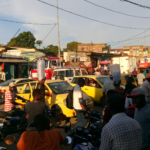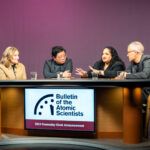Bulletin of the Atomic Scientists publishes findings of Japan’s Independent Review Commission report on Fukushima, with eye- witness accounts of the disaster
By John Mecklin | March 11, 2014
Bulletin Media Contact: Janice Sinclaire, [email protected]
CHICAGO– March 11, 2014–To commemorate the third anniversary of one of the worst-ever civilian nuclear disasters, the Bulletin of the Atomic Scientists, in association with the Rebuild Japan Initiative Foundation, today published the expanded and updated English-language version of the findings of Japan’s Independent Investigation Commission on the Fukushima Nuclear Accident.
Acting as a civilian accident investigation committee, the commission’s expert team of more than thirty scientists, engineers, social scientists, business people, lawyers, and journalists interviewed over 300 individuals—from nuclear plant operators to the prime minister. The goal was to gather “unfiltered experiences of the accident,” free from prevailing assumptions about Japan’s technical prowess and purported attention to safety.
Executive Director Kennette Benedict said the Bulletin’s main purpose for publishing an English-language version of the committee’s findings was to take readers deep into the cultural and historical assumptions surrounding nuclear power in Japan, a context well-known to Japanese citizens, but not necessarily to the rest of the world. “The ‘nuclear power village’ is a massive system that permeates every aspect of Japanese society,” Benedict said. “Our goal is to make explicit to an English-speaking audience what was taken for granted by the industry, by policy makers, and by the general public in Japan and elsewhere.”
This paperback edition of the report is entitled The Fukushima Daiichi Nuclear Power Station Disaster; Investigating the Myth and Reality, and is available through Routledge, a leading academic publisher in the humanities and social sciences.
About the Bulletin of the Atomic Scientists:
Founded in 1945 by University of Chicago scientists who helped develop the first atomic weapons in the Manhattan Project, the Bulletin of the Atomic Scientists informs policy makers and citizens about the risks to humanity from nuclear weapons, nuclear energy, and climate change, by bridging the gap between technical experts and lay audiences. Its Doomsday Clock uses the imagery of apocalypse (midnight) and the contemporary idiom of nuclear explosion (countdown to zero) to convey threats to humanity and the planet and is a universally recognized indicator of the world's vulnerability to catastrophe from nuclear weapons, climate change, and other technological threats to humanity. It won a National Magazine Award for General Excellence in 2007.
Bulletin Media Contact: Janice Sinclaire, [email protected]
Together, we make the world safer.
The Bulletin elevates expert voices above the noise. But as an independent nonprofit organization, our operations depend on the support of readers like you. Help us continue to deliver quality journalism that holds leaders accountable. Your support of our work at any level is important. In return, we promise our coverage will be understandable, influential, vigilant, solution-oriented, and fair-minded. Together we can make a difference.














